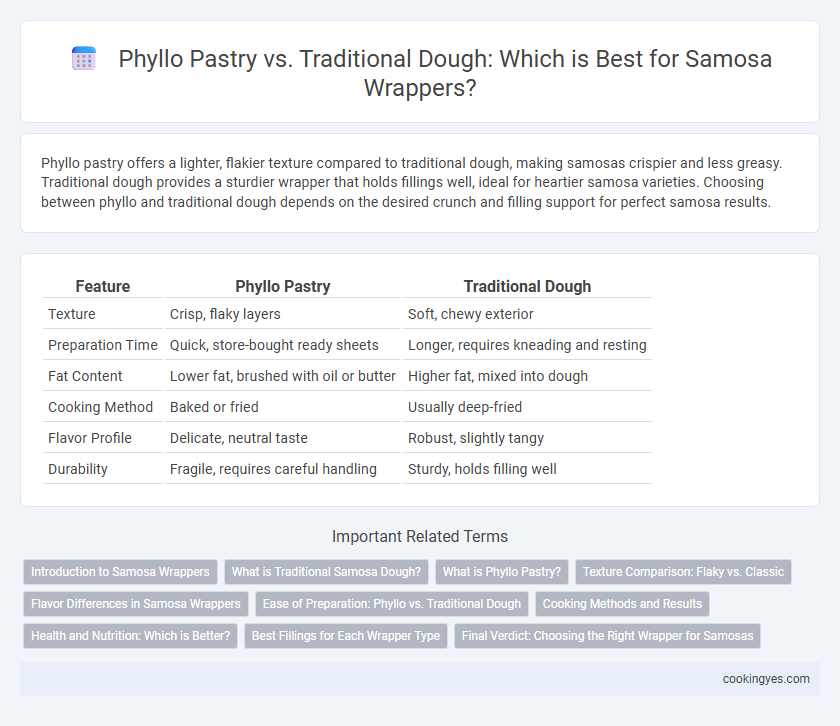Phyllo pastry offers a lighter, flakier texture compared to traditional dough, making samosas crispier and less greasy. Traditional dough provides a sturdier wrapper that holds fillings well, ideal for heartier samosa varieties. Choosing between phyllo and traditional dough depends on the desired crunch and filling support for perfect samosa results.
Table of Comparison
| Feature | Phyllo Pastry | Traditional Dough |
|---|---|---|
| Texture | Crisp, flaky layers | Soft, chewy exterior |
| Preparation Time | Quick, store-bought ready sheets | Longer, requires kneading and resting |
| Fat Content | Lower fat, brushed with oil or butter | Higher fat, mixed into dough |
| Cooking Method | Baked or fried | Usually deep-fried |
| Flavor Profile | Delicate, neutral taste | Robust, slightly tangy |
| Durability | Fragile, requires careful handling | Sturdy, holds filling well |
Introduction to Samosa Wrappers
Phyllo pastry and traditional dough serve as popular options for samosa wrappers, each offering distinct textures and flavors. Traditional dough, made from a simple blend of flour, water, and oil, provides a thicker, crispier shell ideal for holding hearty fillings without sogginess. Phyllo pastry, characterized by its ultra-thin, layered sheets, creates a delicate, flaky crust that adds a lighter crispness and a different mouthfeel to the classic samosa experience.
What is Traditional Samosa Dough?
Traditional samosa dough is typically made from all-purpose flour, water, salt, and oil or ghee, creating a firm and pliable texture essential for holding the filling during deep frying. Unlike phyllo pastry, which is extremely thin and flaky, traditional dough provides a sturdier, crisp exterior that resists oil absorption, resulting in a satisfying crunch. This dough's elasticity and thickness ensure the samosa retains its shape and delivers the classic mouthfeel associated with authentic samosas.
What is Phyllo Pastry?
Phyllo pastry is a paper-thin, unleavened dough made from flour, water, and a small amount of oil or vinegar, characterized by its crisp and flaky texture when baked or fried. Unlike traditional samosa dough, which is thicker and more pliable, phyllo pastry creates delicate, layered wrappers that provide a lighter and crispier bite. This pastry is commonly used in Mediterranean and Middle Eastern cuisines, offering a unique alternative for samosas aiming for an elegant, crunchy exterior.
Texture Comparison: Flaky vs. Classic
Phyllo pastry samosa wrappers deliver a delicate, flaky texture that crisps quickly and shatters gently with each bite, contrasting sharply with the traditional dough's robust, chewy consistency. The traditional dough, made from all-purpose flour and water, yields a heartier bite that holds fillings securely during frying, resulting in a golden-brown crust with a satisfying crunch. Texture preference depends on culinary goal: phyllo offers lightness and layered flakiness, while classic dough emphasizes substance and durability.
Flavor Differences in Samosa Wrappers
Phyllo pastry offers a lighter, flakier texture with a subtle buttery flavor that enhances the overall crispiness of samosas, contrasting with the traditional dough's denser, chewier bite and pronounced savory taste. Traditional dough samosa wrappers typically provide a richer, wheat-forward flavor profile due to their thicker composition and incorporation of spices like ajwain or cumin. Flavor differences in these wrappers significantly influence the eating experience, with phyllo pastries delivering a delicate crunch and traditional dough imparting a heartier, more robust base for the filling.
Ease of Preparation: Phyllo vs. Traditional Dough
Phyllo pastry offers a significant advantage in ease of preparation for samosa wrappers due to its pre-rolled, thin sheets that require minimal handling and no kneading, saving time and effort. Traditional dough demands meticulous kneading, resting, and rolling to achieve the correct elasticity and thickness, which can be time-consuming and requires more skill. Using phyllo simplifies the process, making samosa preparation accessible to beginners while maintaining a crisp texture.
Cooking Methods and Results
Phyllo pastry offers a delicate, flaky texture when baked, providing a lighter and crispier samosa wrapper compared to traditional dough, which is typically deep-fried for a golden, crunchy exterior. Baking with phyllo reduces oil absorption, resulting in a less greasy samosa that emphasizes flakiness and layered crispness. Traditional dough, made with flour and water, yields a thicker, sturdier shell that holds heavier fillings better and delivers a robust, satisfying crunch after frying.
Health and Nutrition: Which is Better?
Phyllo pastry samosa wrappers are typically lower in fat and calories compared to traditional dough, making them a healthier choice for calorie-conscious individuals. Traditional dough, often made with refined flour and sometimes deep-fried, can contain higher levels of saturated fats and carbohydrates, which may impact blood sugar and heart health negatively. Phyllo sheets, being thin and layered, allow for less oil absorption during cooking, enhancing the samosa's nutritional profile by reducing unhealthy fat content.
Best Fillings for Each Wrapper Type
Phyllo pastry offers a delicate, flaky texture ideal for lighter fillings such as spiced vegetables, paneer, or chicken mince, enhancing the crispiness without overpowering the taste. Traditional dough provides a sturdier, thicker wrap suited for robust, hearty fillings like spiced lamb, potatoes with peas, or lentils, holding up well during deep frying without falling apart. Pairing phyllo with mild, finely chopped ingredients maximizes its thin layers, while traditional dough complements chunky and moisture-rich fillings that require durability.
Final Verdict: Choosing the Right Wrapper for Samosas
Phyllo pastry offers a crispier, flakier texture for samosas, enhancing their crunch and lightness, while traditional dough delivers a thicker, chewier wrapper with a more robust, homemade flavor. Choosing the right wrapper depends on desired texture and cooking style; phyllo suits baking or light frying, whereas traditional dough withstands deep frying and holds hearty fillings better. For a balance of authenticity and crunch, many chefs prefer traditional dough, but phyllo is ideal for a delicate, modern twist on classic samosas.
Phyllo pastry vs traditional dough for samosa wrappers Infographic

 cookingyes.com
cookingyes.com